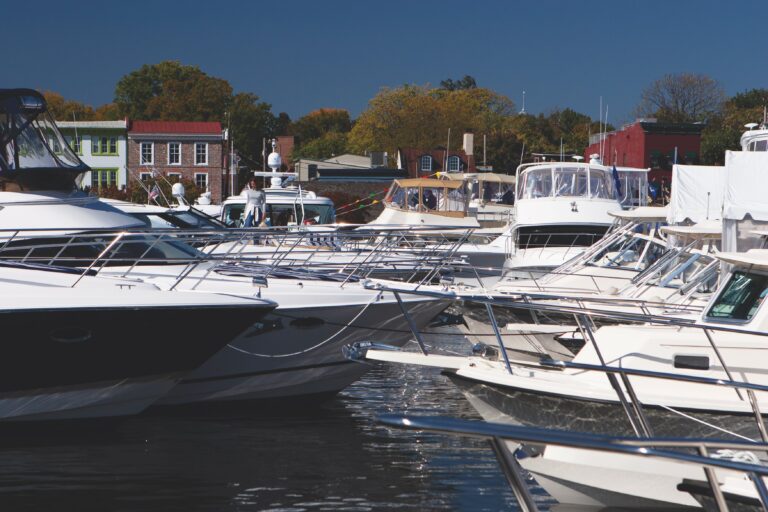Supreme Court rules for Florida activist, deciding his engine-less, steering-less dwelling was not a ‘vessel’

Tangle with Fane Lozman at your own risk. The city of Riviera Beach, Fla., did in a case that went all the way to the U.S. Supreme Court. Was Lozman’s floating home a vessel? By a 7-2 vote the justices agreed with him that it was not.
The ex-Marine pilot, retired Chicago commodities trader and multimillionaire trading software developer says the Jan. 15 decision can’t rescue his floating home from a landfill, but it vindicated his belief that the boxy two-story structure with no engines or steering was no vessel. U.S. marshals seized it under admiralty law and auctioned it to the highest bidder, Riviera Beach, which destroyed it.
But after three years of fighting the city in court, Lozman, 51, says justice is sweet. He will seek compensation for the loss and for attorneys’ fees — about $300,000. “This is too late for my floating home,” he says, “but the owners of some 3,000 other floating homes, in the Southeast, especially, will not have to go through what I did.”
The high court’s decision overturned a ruling by the 11th U.S. Circuit Court of Appeals in Atlanta — whose jurisdiction is the Southeast — that a floating home is a vessel. The 11th Circuit’s ruling was at odds with recent decisions in other appellate courts across the nation, the 5th in New Orleans and the 7th in Chicago, in particular.
Lozman likes to be in the thick of the fray. Retired to Riviera Beach, he became a civic activist during a 2006 fight against a $2.4 billion city plan to redevelop 400 acres of waterfront into a high-end, residential-commercial-marine district. The project would have pushed out slip holders at the Riviera Beach Marina, where Lozman lived on his floating home, gobbled up 1,700 landside homes, displaced 5,100 residents and closed many small businesses through eminent domain. The activists won the day, but Lozman did not endear himself to city officials.
First, he says, they tried to evict him from the marina because he wouldn’t muzzle his 10-pound dachshund, which they described as “dangerous,” and because he allegedly hired unlicensed repairmen to work on his home. He beat back the eviction in a jury trial in state court on grounds it was retaliation. Then the city adopted new marina rules requiring tenants to register their craft as vessels and keep them operational so they could vacate the marina in an emergency.
Lozman’s floating home couldn’t comply with the mandates, but he refused to leave the marina, and the city said he failed to pay $3,000 in rent. So it filed an “in rem” suit against his floating home in U.S. District Court, alleging trespass and seeking a maritime lien against the home to the tune of $3,000.
Lozman’s Supreme Court brief describes a maritime lien as an “extraordinary remedy tailored to federal maritime law that attaches to a vessel without notice to the owner and allows an automatic seizure of the vessel without providing an opportunity to be heard.”
“I couldn’t believe it,” Lozman says. “Three armed federal marshals came to my home, broke down the door and took it under tow [along with all of his possessions]. I was made homeless. That shouldn’t happen in America. Even now it makes my blood boil. I had to go to the hearing [the next day] wearing clothes I bought at the thrift shop.”
Auctioned and destroyed
Lozman, representing himself, later argued before the district court that his floating home was not a vessel under federal law and, therefore, was not subject to seizure under admiralty. The district court rejected his arguments, found Lozman delinquent in his rent in the amount of $3,039.88, awarded the city $1 for the trespass claim, and ordered the home auctioned. The city attended the auction, submitted the highest bid for the floating home and destroyed it.
The 11th Circuit Court of Appeals affirmed the decision, but that didn’t deter Lozman, who was sure he was right and had common sense on his side. His lawyer, Jeffrey Fisher, a Stanford University law professor and one of the nation’s leading Supreme Court litigators, says he was pretty sure Lozman was right, too.
“As someone who lived in Seattle for six years, I’ve got a pretty good idea of what a floating home is,” Fisher says. “I would say part of the reason I was willing to take this case on was that I was pretty sure the way the 11th Circuit applied the law was overly broad and had got things very wrong.”

Florida and most other states treat floating homes — not houseboats, which are motorized and designed to operate as boats — as real property. Florida assessors put them on their rolls as homes and tax them accordingly. Lozman’s floating home was even awarded a homestead exemption, which entitles resident homeowners to a discount on their property tax. As a home, not a vessel, Lozman’s floating home also would have been protected against creditors under Florida’s constitution, which has some of the strongest protections in the country for homeowners. “The 11th Circuit said, ‘We don’t care what the state laws say,’ ” Lozman says. “Anything that floats is a boat.”
Writing for the Supreme Court majority, Justice Stephen Breyer says some lower-court interpretations of the federal definition of a vessel were so broad that, as one judge put it, they could encompass three men in a tub and even Jonah inside the whale. Federal law defines a vessel as including “every description of watercraft or other artificial contrivance used, or capable of being used, as a means of transportation over water.” So is a floating home a vessel? “In answering that question, we focus primarily upon the phrase ‘capable of being used … as a means of transportation on the water,’ ” Breyer writes in his opinion.
Breyer says the 11th Circuit Court of Appeals had found that Lozman’s floating home — a 60-by-12-foot, two-story plywood structure with a flat bottom, a 10-inch deep rectangular hull (no rake forward), no motors, no generator, no batteries, no rudder or steering — met that standard because it could float and be towed, and its power cable, water hose and lines could be disconnected so it could be moved.
Breyer says the 11th Circuit’s interpretation was too broad. “Not every floating structure is a ‘vessel’,” he writes. “To state the obvious, a wooden washtub, a plastic dishpan, a swimming platform on pontoons, a large fishing net, a door taken off its hinges, or Pinocchio (when inside the whale) are not ‘vessels,’ even if they are ‘artificial contrivances’ capable of floating, moving under tow and incidentally carrying even a fair-sized item or two when they do so.”
Breyer’s test
Breyer offered his own more common-sense test for applying the federal definition of a vessel. “We believe that a reasonable observer, looking to the [floating] home’s physical characteristics and activities, would not consider it to be designed to any practical degree for carrying people or things on water. And we consequently conclude that the floating home is not a ‘vessel,’ ” he writes.
Key indicators of whether it’s a vessel are the structure’s physical characteristics and what it typically does. Do these suggest to a “reasonable observer” that “to any practical degree” the structure was designed to transport people or things on the water? So another indicator is, “Was it in any practical way designed to carry people or things on the water?” Lozman’s home flunks the test.
The case — Lozman proudly asserts that many are now referring to the decision as the “Lozman rule” — drew a lot of interest in the world of admiralty law. The American Gaming Association, representing 61 dockside casinos, filed a friend of the court brief supporting Lozman because the 11th Circuit’s ruling could put workers on dockside casinos under the jurisdiction of the Jones Act, which protects seamen.
The Seattle and Sausalito floating home associations, representing 500 floating home owners, also sided with Lozman, arguing that if the 11th Circuit’s decision were upheld it would “radically alter” the rules affecting floating homes by bringing them under admiralty instead of local and state law.
Even the U.S. government came to Lozman’s defense, saying the 11th Circuit’s definition of a vessel would needlessly bring floating structures under the Coast Guard’s safety and inspection regime. The National Marine Bankers Association, on the other hand, threw its weight behind Riviera Beach, thinking the appellate ruling provided a “clear and objective standard” for determining what a vessel is for the trade group’s purposes, which is making loans and securing them with maritime liens.
The Maritime Law Association of the United States, representing 3,000 lawyers, also backed the city, arguing that the 11th Circuit’s decision provided a simple test for deciding what a vessel is: “Is the object used as a means of transportation on water or, if not, is it capable of being so used? If the answer to either question is yes, the object is a vessel under U.S. law.”
Breyer, writing for justices John Roberts, Antonin Scalia, Clarence Thomas, Ruth Bader Ginsburg, Samuel Alito and Elena Kagan, says that test encompasses way too much. “But for the fact that it floats, nothing about Lozman’s home suggests that it was designed to any practical degree to transport persons or things over water,” he writes.
Future implications
Responding to critics who say the Supreme Court has muddied the waters and made it more difficult to decide whether some “contrivance” is fish or fowl — vessel or no — Fisher responds, “I think it is as clear as it can be. There’s no perfect verbal formulation. I think the court’s opinion that you should ask what something is designed to do and look at its attributes for doing that is a pretty good way to go.”
That’s Breyer’s contention, too. “We believe the criteria we have used, taken together with our example of its application here, should offer guidance in a significant number of borderline cases where ‘capacity’ to transport over water is in doubt.” He says the high court’s formulation is far better than the overly inclusive “anything-that-floats” test.
In a dissenting opinion, Justice Sonia Sotomayor, joined by Justice Anthony Kennedy, thought the majority’s reliance on a “reasonable observer looking to the [craft ’s] physical characteristics and activities” to discern whether it was designed to carry people or things on the water introduced a subjective element that would cause confusion.
Riviera Beach city attorney Pamala Ryan says she is disappointed by the outcome but will change the marina rules and policies to reflect the court’s decision. “We want to try to avoid this situation from happening again,” she says. “We won’t allow boats that we don’t believe are vessels.”
In borderline cases in which something may not look or act like a boat, the city may have to err on the side of caution and decline admittance, she says. Ryan believes the marina will have to write its own definition of a vessel and use that as its litmus test. She says it also will have to work out contract language for dealing with vessels that change their status during their stay at the marina — for instance, if they jettison or lose use of their engine or engines so they no longer can move in or out of the marina on their own power.
The Riviera Beach Marina, which recently underwent an $11 million renovation and expansion, allows liveaboards, but Ryan says the city does not want the marina to become anyone’s permanent home — or, as state law describes it, “homestead,” which could take the vessel into that borderline area where it is not behaving like a vessel. “We’re still working out the kinks,” she says.
This article originally appeared in the May 2013 issue.











